Ryobi P516 18V Reciprocating Saw Review
- May 22, 2024
- 0 comment
When it comes to tackling a variety of cutting jobs around the house, the Ryobi P516 18V Reciprocating Saw promises both power and convenience. This tool isn’t just another saw; it’s a handy companion for any DIY enthusiast.

Let’s dive into what makes the Ryobi P516 a worthy addition to your toolkit and cover some of the practical aspects that every potential buyer should know.
Specifications of Ryobi P516 Reciprocating Saw
- Voltage: 18V
- Stroke Rate: Up to 2900 strokes per minute
- Stroke Length: 28 mm
- Weight: 2.8 kg (6.17 lbs)
- Dimensions: 17.5 x 4.3 x 6.5 inches
- Sound Power Level: 91.5 dB(A)
- Vibration Level (Cutting Logs): 16.2 m/s²
- Battery Compatibility: Works with Ryobi Lithium-Ion batteries (not included)
Ryobi Reciprocating Saw Design and Handling
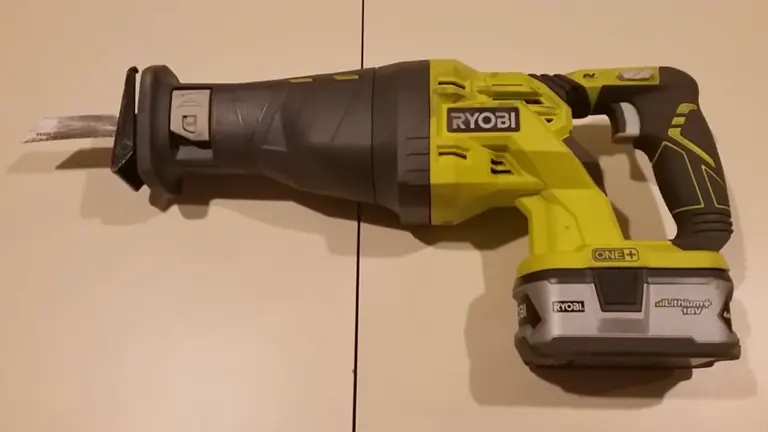
Right off the bat, the Ryobi P516 stands out with its vibrant green color and sturdy construction. It weighs around 5 pounds, which strikes a good balance between being lightweight enough for prolonged use without fatigue and hefty enough to feel solid and reliable in your hands. The rubber grip and anti-vibration handle are thoughtful touches, adding comfort and stability, which are especially appreciated during longer projects.
Power and Performance

Powered by Ryobi’s robust 18V motor, the P516 offers up to 2,900 strokes per minute, making it 40% more powerful than its predecessor, the P514. This increase in power translates to smoother, more efficient cutting across a variety of materials. Whether it’s wood, PVC, or even metal, the P516 handles it with ease, thanks to its adjustable shoe that allows for precise control over the depth of each cut.
Ease of Use
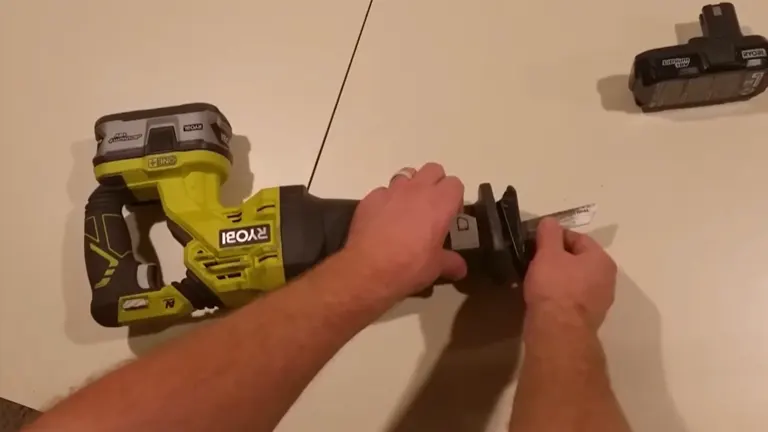
One of the standout features is the tool-less blade changing mechanism. The lever-actuated system allows you to swap out blades quickly and without the need for additional tools, which is a huge time-saver. The saw is also compatible with a wide range of Ryobi Lithium Ion batteries, from the latest One+ system to the older blue series, ensuring you can always find a battery when needed.
Durability
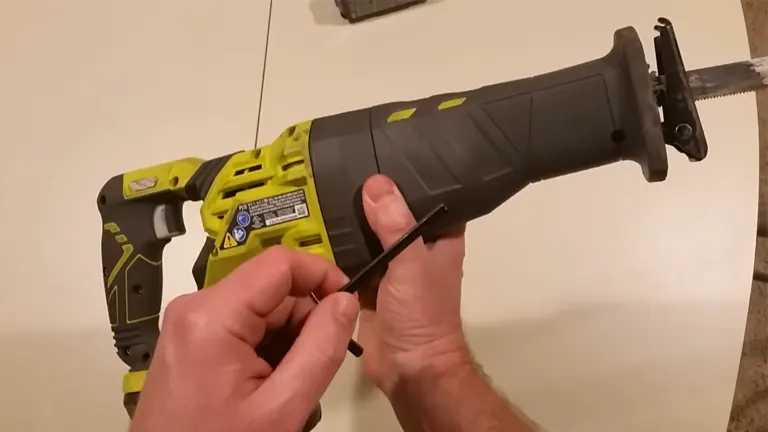
Although generally robust, it’s worth noting that the P516’s electric motor can overheat if pushed too hard for too long. This saw is not designed for continuous, heavy-duty use without breaks. The shoe component, while sturdy, may require occasional tightening as it can loosen with extensive use. Keeping an Allen key handy for quick adjustments is a good practice.
Price and Value
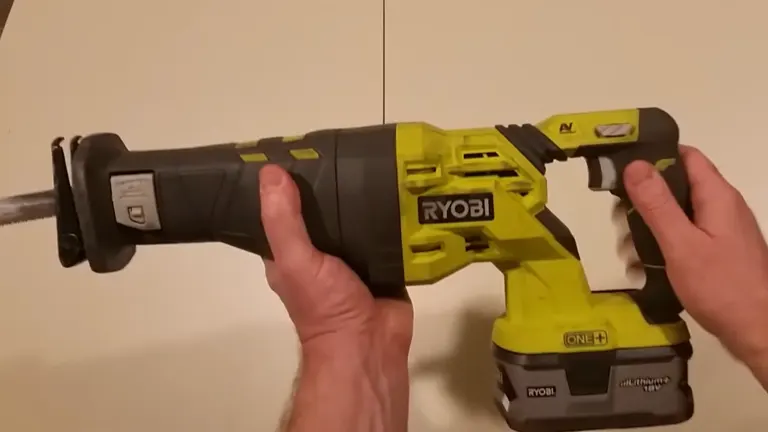
At $130.00, the Ryobi P516 is priced competitively, offering good value considering its features like the anti-vibration handle and the enhanced power output. It’s an excellent choice for DIYers who need a reliable, versatile tool for occasional to moderate use around the home.
Here’s What I Loved about Ryobi P516
- Right from the start, the saw’s lightweight design made it super easy to handle. Whether I was reaching up to trim branches or cutting through old pipes, the balance was spot on, which really helped in reducing fatigue during longer jobs.
- The 2,900 strokes per minute were a noticeable boost over older models. This saw slices through materials smoothly and quickly, which made my projects not only easier but also a lot faster.
- I absolutely appreciate the tool-less blade change mechanism. It’s a real game changer, allowing me to switch blades in a flash without rummaging for tools.
- The anti-vibration handle is another highlight. It significantly reduces the stress on my hands and wrists, which is a huge plus for those longer projects.
- Being able to use the same battery across different tools is a huge advantage, especially since I own several Ryobi products. This compatibility means I’m always powered up and ready to go.
But It’s Not All Perfect
- I learned quickly that this saw isn’t cut out for non-stop, heavy-duty work. It tends to overheat, which can be a bit of a setback. Giving it a breather after intense sessions becomes essential to keep it running smoothly.
- The shoe adjustment loosened a few times during use, which was annoying. Now, I make it a habit to tighten it before starting any job to avoid any slip-ups.
Maintenance Tips for the Ryobi P516 18V Reciprocating Saw
- Regular Cleaning: After every use, it’s important to clean your Ryobi P516 to prevent dust and debris from accumulating. Use a soft brush or compressed air to clear out particles from around the blade, motor vents, and battery compartment. This keeps the tool running smoothly and prevents overheating. For a more thorough clean every few months, wipe the exterior with a damp cloth, avoiding harsh chemicals that might damage the tool’s components.
- Blade Maintenance: Regularly inspect the blades for signs of dullness, bending, or chipping. A sharp blade is crucial not only for effective cutting but also for the health of your saw’s motor, as it reduces the amount of force needed to cut through materials. Replace any worn blades promptly, and store spares in a dry, safe place to prevent rust.
- Battery Care: Always charge the Ryobi P516 batteries using the original charger and try to recharge them when they reach 20-40% capacity to prolong battery life. If you’re not planning to use the saw for a while, remove the battery and store it in a cool, dry place to avoid damage.
- Lubrication: Keep the blade mechanism lightly oiled; this helps maintain smooth operation and prevents rust, especially if you’re working in harsh conditions or use the saw extensively. Apply a dry lubricant to other moving parts as needed, ensuring they remain free from stiffness and noise.
- Check for Wear and Tear: Pay attention to the saw’s foot plate and ensure it remains secure and isn’t excessively worn, as this can impact cutting depth and accuracy. Also, listen to the motor and check for excessive heat or unusual noises. Regularly cleaning the vents is crucial to maintain proper motor ventilation.
- Safety Checks: Regular checks of the trigger and safety lock are essential to ensure they function correctly, preventing accidental starts. Also, inspect the electrical cords and battery contacts for signs of wear, fraying, or corrosion, and clean them with a dry cloth as needed.
- Tighten Fasteners: Due to the vibrations during use, screws and fasteners can become loose over time. Periodically, go through and tighten these components to ensure the saw remains stable and safe to use.
Troubleshooting Common Issues with the Ryobi P516 18V Reciprocating Saw
Even with proper care and maintenance, you might encounter some common issues with the Ryobi P516 Reciprocating Saw. Here’s how to troubleshoot and resolve these effectively:
- Saw Blade Slipping or Not Holding: If you notice the blade slipping or not holding properly, the issue might be with the blade clamp. First, ensure that the blade is correctly inserted and secured. If problems persist, inspect the blade clamp for any debris or damage that might be preventing it from locking the blade securely. Cleaning the clamp and checking for wear can often resolve this issue.
- Excessive Vibration: While the Ryobi P516 features an anti-vibration handle, excessive vibration can still occur, particularly if the saw blade is dull or improperly installed. Check to make sure the blade is sharp and correctly seated in the clamp. If the vibration continues, inspect the saw for loose screws or components and tighten them as needed.
- Overheating During Use: If your saw begins to overheat, it’s usually a sign of excessive use without adequate breaks. Allow the saw to cool down completely before attempting to use it again. To prevent overheating, avoid continuous heavy use and ensure the vents are clear of any obstructions to maintain proper airflow.
- Battery Drains Quickly: If the battery seems to drain more quickly than usual, first check whether the battery is properly charged and calibrated. If it’s an older battery, it might be reaching the end of its lifecycle. Consider replacing it with a new one. Also, using the correct blade for the material being cut can reduce workload and extend battery life.
- Loss of Cutting Power: A decrease in cutting power can often be attributed to using a dull blade. Replace the blade if it shows signs of wear. Additionally, ensure that you’re using the appropriate type of blade for the material you are cutting. If the issue isn’t resolved by changing the blade, inspect the battery and motor for any potential faults.
- Motor Making Unusual Noises: Unusual noises from the motor can indicate a serious issue. Stop using the saw immediately to avoid further damage. Check for any obstructions or debris in the blade area and motor vents. If the saw is clean and the noise persists, it may require professional servicing to check for internal damage.
- Saw Not Starting: If the saw fails to start, ensure that the battery is charged and properly inserted. Check the condition of the battery contacts and clean them if necessary. Also, inspect the trigger mechanism for any signs of damage or obstruction.
Conclusion
Overall, the Ryobi P516 18V Reciprocating Saw is a solid choice for anyone looking to enhance their tool collection for home projects. It’s powerful, user-friendly, and adaptable to various cutting tasks. While it has a couple of minor drawbacks, its advantages in terms of performance, ease of use, and cost-effectiveness make it a recommended buy. Whether you’re pruning trees, cutting pipes, or dismantling old furniture, the Ryobi P516 has the power to get the job done right. If you’ve used this tool or have any tips or questions, feel free to share your thoughts in the comments below—let’s help each other tackle our projects with the best tools available!
FAQs
- What makes the Ryobi P516 different from other reciprocating saws on the market?
The Ryobi P516 stands out due to its impressive stroke rate of up to 2900 strokes per minute and its compatibility with a wide range of Ryobi batteries. It also features an anti-vibration handle which significantly reduces fatigue during long use, a feature not commonly found in other saws at this price point. - Can I use the Ryobi P516 for cutting materials other than wood?
Absolutely! While it’s excellent for wood, the Ryobi P516 is also capable of cutting through metal, plastic, and even ceramic if equipped with the appropriate blade. This versatility makes it an ideal tool for various home renovation and repair projects. - Is the Ryobi P516 suitable for professional use?
While the Ryobi P516 is powerful and versatile enough for professional tasks, it is primarily designed for home DIY projects. Professionals might find it useful as a secondary or backup tool due to its portability and ease of use. - How does the tool-less blade change feature work?
The Ryobi P516 features a lever-actuated mechanism that allows you to change blades quickly and easily without the need for additional tools. Simply lift the lever, insert a new blade, and secure it back in place—a hassle-free process that saves time and effort. - What should I do if my Ryobi P516 starts to overheat?
If the saw starts to overheat, it’s best to stop working and let it cool down before resuming your task. Continuous operation when overheating can lead to motor damage. For optimal performance, give the tool a break during extended use to prevent overheating. - How do I maintain my Ryobi P516 to ensure it lasts?
To maintain your Ryobi P516, keep it clean and free of dust and debris after each use. Check and tighten any loose parts regularly, and ensure the blade is sharp and in good condition. Store it in a cool, dry place to avoid any moisture damage. - Can the Ryobi P516 be used with any Ryobi battery?
The Ryobi P516 is compatible with all Ryobi 18V One+ batteries, offering great flexibility, especially if you already own other Ryobi tools. It does not include a battery, so purchasing a higher capacity Ryobi battery for a longer run time might be beneficial.
We hope this review and the FAQs have helped you get a better understanding of the Ryobi P516 18V Reciprocating Saw! If you have any questions we haven’t covered or if you’d like to share your experiences with this tool, please drop a comment below. Your insights and tips are invaluable and can help others make informed decisions. If you found this information helpful, feel free to share it with friends or on social media. Let’s keep the conversation going and help each other tackle those DIY projects with the best tools available!

David Murray
Forestry AuthorI'm David Murry, a forestry equipment specialist with a focus on chainsaw operation. With over 13 years of experience, I've honed my skills in operating and maintaining a wide range of machinery, from chainsaws to log splitters. My passion for the outdoors and commitment to sustainable forestry drive my work, which emphasizes safety, efficiency, and staying updated with industry advancements. Additionally, I'm dedicated to sharing my expertise and promoting environmental awareness within the forestry community.

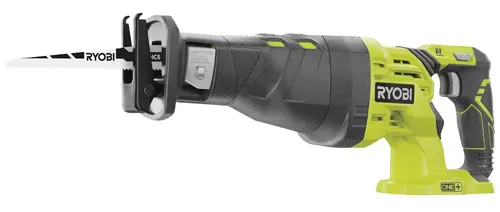
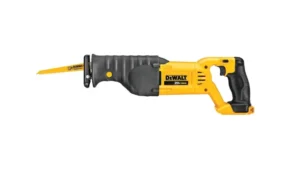
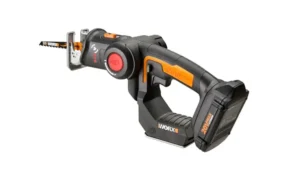
Leave your comment